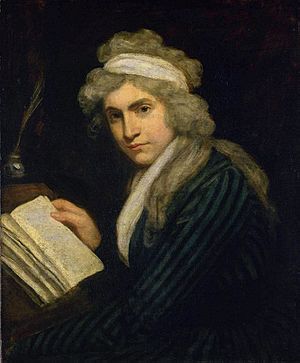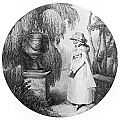Mary: A Fiction facts for kids
Mary: A Fiction is a novel written by Mary Wollstonecraft. She was a British writer and an early feminist. This means she believed in equal rights for women. Mary was her first and only complete novel.
Wollstonecraft wrote the book in 1788 while she was working as a governess in Ireland. A governess was a woman who taught children in a private home. Becoming a writer was not a common job for women in the 1700s in Britain.
The story is about a young woman named Mary. It explores her close friendships with another woman and a man. Mary Wollstonecraft was inspired by Jean-Jacques Rousseau, a famous thinker. He believed that truly brilliant people, or "geniuses," learn mostly by themselves. So, Wollstonecraft made Mary a self-taught character.
Mary is shown as a strong and independent person. She thinks for herself about what it means to be a woman and about marriage. Her unique ideas and her refusal to follow old-fashioned rules make her a genius. The novel also criticizes marriage and the idea of "sensibility" in the 1700s. Sensibility was a focus on strong emotions, which Wollstonecraft felt could harm women.
Contents
About Mary Wollstonecraft
Mary Wollstonecraft (1759–1797) was an important writer and philosopher. She is best known for her book A Vindication of the Rights of Woman (1792). In this book, she argued that women should have the same education as men. She believed that women were just as smart as men and could contribute a lot to society if given the chance. Her ideas were very advanced for her time.
The Story of Mary
The novel follows Mary, a young girl who is often lonely. Her parents don't pay much attention to her. She finds comfort and understanding in her friendships. One important friendship is with a woman named Ann. The other is with a man named Henry. These friendships are very deep and meaningful to Mary.
Mary's journey in the novel shows her growing up and learning about the world. She faces challenges and tries to find her own path. The book highlights her strong will and her desire to live life on her own terms.
Mary's Ideas on Society
Mary, the character, has strong opinions about how society works. She questions the traditional roles for women. She also thinks about how marriage was seen in her time. Many marriages were arranged for money or social status, not for love or partnership. Mary believes that women should have more freedom and control over their own lives.
The novel also looks at the idea of "sensibility." In the 18th century, it was popular for people, especially women, to show strong emotions. Wollstonecraft thought that too much focus on emotions could make women weak or easily controlled. Through Mary, she suggests that women should use their reason and intelligence, not just their feelings.
Inspiration and Impact
Wollstonecraft used ideas from other writers, like Jean-Jacques Rousseau, to create Mary's character. Rousseau believed that true genius came from within and was not taught in schools. Mary, in the novel, learns a lot by herself and develops her own unique way of thinking.
Mary: A Fiction was published in 1788. It was one of the first novels to explore these ideas about women's independence and societal expectations. It showed that women could be strong, intelligent, and capable of making their own choices. This novel helped to set the stage for Wollstonecraft's later, more famous works on women's rights.
Images for kids
-
Title page from Mary: A Fiction; epigraph by Rousseau reads: "L'exercice des plus sublimes vertus éleve et nourrit le génie" ("the exercise of the most sublime virtues raises and nourishes genius")
-
Rousseau's Julie, or the New Heloise (1761), from which Wollstonecraft drew the epigraph for Mary
-
Charlotte at Werther's tomb in Goethe's The Sorrows of Young Werther (1774)
See also
 In Spanish: La novela de María para niños
In Spanish: La novela de María para niños






